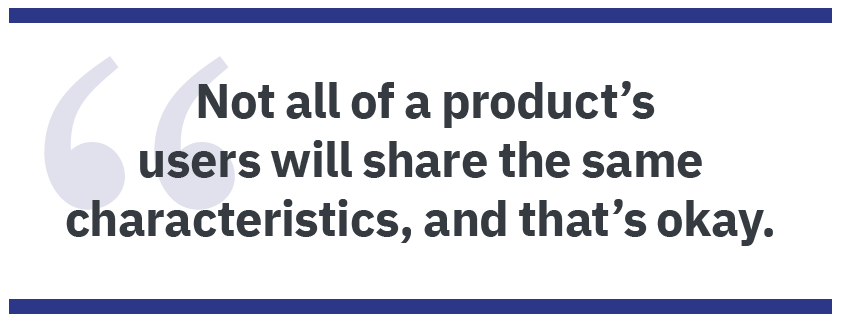By Gini Martinez
Exploratory UX research helps you to identify user needs to effectively develop and communicate usable solutions.
A product’s usability, which is defined by the Interaction Design Foundation as, “a measure of how well a specific user in a specific context can use a product/design to achieve a defined goal effectively, efficiently and satisfactorily,”1 is essential to a product’s success. However, before product content can be designed to facilitate effective, efficient, and satisfactory user goal achievement, those goals need to be clearly defined and understood. That’s where user experience (UX) research comes to play. UX research is the methodological process of gathering contextual feedback from users regarding their jobs to be done and any related pain points. UX researchers are curious to make discoveries about users and the goals they are having difficulty achieving, and the insights their work produces are an essential reference for any product team.
Getting to Know Your Audience

Imagine you’re working on a product that helps connect people who like to pet dogs with people who own dogs and are happy to let strangers pet them. (In this example, both the people seeking dogs to pet and the people providing the dogs would be considered users, but for the purpose of this exercise, we will focus solely on the former.) Conducting qualitative exploratory UX research by interviewing a handful of people who like to pet dogs can help a product team to empathize with who they are and what they need in order to create the most valuable solution (product) for them and communicate that solution effectively.
Research can help us to better understand the goals of people seeking dogs to pet:
- What motivates people to want to pet dogs? Maybe the goal is to relieve anxiety, to study the pet-able-ness of different breeds, to lower blood pressure, or to have some fun.
- What barriers do people encounter when trying to achieve their dog petting goals? They might have trouble locating dogs nearby or with owners who don’t mind sharing their dogs with strangers.
- What about the context in which users are trying to achieve their goals? Maybe people like to plan ahead to pet dogs versus needing to find dogs in real time.
Research can tell us more about the demographics of people who seek dogs to pet:
- Are young people more interested in petting dogs?
- Do potential dog petters live in apartments or single-family homes?
- Is it more common for full-time students or employees to seek out dogs to pet?
Research can shed light on the psychographics of people who seek dogs to pet:
- What do they believe in? Maybe they are parents who think it’s important to socialize their children with dogs but aren’t allowed to keep one in their apartment.
- What do they value? Maybe they prefer alternative means to treat high blood pressure versus taking medication.
- What do they aspire to? Maybe their goal is to one day meet a dog from each breed and check them off their bucket list.
Research can shed light on the behavior of people who seek dogs to pet:
- Are they likely to join community groups?
- Do potential dog petters follow a lot of animal content on social media?
- Is it common for them to keep a To Do list?
All of these elements not only help product development, but content development as well.
Informing User-Centered Design
If you’re familiar with the double diamond2 approach to design thinking, you know that it begins with divergent thinking, which is about being curious and keeping an open mind about if and how a problem exists in the world. Divergent thinking is the essence of discovery and discovery is the theme of exploratory UX research. With that in mind, you can see that UX research focuses deeply on the problem potential dog petters have. Insights gleaned during UX research can help to inform user-centered design decisions made about the product.
How insights gleaned during exploratory UX research can influence what a product for people who seek dogs to pet might look like:
- Do many of them want to find dogs while they are on the go? Maybe the solution needs to be a mobile application.
- Are many potential dog petters parents? Maybe the app needs a filter to find child-friendly dogs.
- Is it important to track the breeds they’ve pet? Maybe there needs to be a master list tab where they can check them off one at a time after petting a dog from each breed, like a birdwatching app.
What if all of a product’s users don’t share the same characteristics?
They won’t, and that’s okay. Discovering trends in the goals, demographics, psychographics, and behaviors of a product’s target market is the objective of exploratory UX research. Often a UX research team will capture the most important trends and turn them into a persona (or personas, if a product has multiple market segments).
A persona is a fictional user who reflects meaningful key attributes of a product’s target market.3 Highlighting and organizing those attributes succinctly onto a single page provides team members with a valuable reference to help guide and focus decisions made about the design and content of the product. The fictional user will usually have an alliterative name and include a photo to help make them memorable to all the product team members.
Know Your Personas
 Here we have Excited Eliza, named so because she gets very excited whenever she meets a new dog. It’s the highlight of her day and always soothes her anxiety. Eliza is a self-aware, organized, high-achieving first year college student who misses her family dog since moving away. The applications she uses multiple times daily include her calendar, a mindfulness app, and a popular photo sharing app. She values spending time outdoors with dogs and other people away from her academics but needs help making that happen.
Here we have Excited Eliza, named so because she gets very excited whenever she meets a new dog. It’s the highlight of her day and always soothes her anxiety. Eliza is a self-aware, organized, high-achieving first year college student who misses her family dog since moving away. The applications she uses multiple times daily include her calendar, a mindfulness app, and a popular photo sharing app. She values spending time outdoors with dogs and other people away from her academics but needs help making that happen.
Having essential insights about Excited Eliza at their fingertips will help everyone involved in creating the solution to her dog petting needs. UX research insights support the decision-making process for designers, information architects, developers, writers, and so on, enabling them to produce a user-centered product that facilitates effective, efficient, and satisfactory user goal achievement for people seeking dogs to pet.
UX Research Sets the Stage for Product Success
Getting UX research into the hands of product team members empowers them to create with the user in mind, which contributes to the product’s usability and ultimate success.
While user feedback should be systematically sought after and valued throughout a product’s lifespan to maximize its impact on product design and usability, it ideally predates the product’s existence in the form of exploratory UX research. After all, how can you know what solution to create if you don’t know exactly what the problem is or who has it?
 References
References
- Interaction Design Foundation. 2022. “Usability.” https://bit.ly/3CNNRqb.
- Humble, Jeff. 2022. “What Is the Double Diamond Process? A Guide for People That Want to Make Sense of Design.” The Fountain Institute. https://www.thefountaininstitute.com/blog/what-is-the-double-diamond-design-process.
- Laubheimer, Page. 2020. “3 Persona Types: Lightweight, Qualitative, and Statistical.” Nielsen Norman Group. https://www.nngroup.com/articles/persona-types/.
 GINI MARTINEZ is an empathetic and curious mixed methods UX researcher with 20 years of client collaboration and workshop facilitation. She is currently a research consultant for a startup while pursuing her master’s in applied cognitive psychology for UX research at Claremont Graduate University. She can be reached at https://www.linkedin.com/in/ginimartinez/
GINI MARTINEZ is an empathetic and curious mixed methods UX researcher with 20 years of client collaboration and workshop facilitation. She is currently a research consultant for a startup while pursuing her master’s in applied cognitive psychology for UX research at Claremont Graduate University. She can be reached at https://www.linkedin.com/in/ginimartinez/



